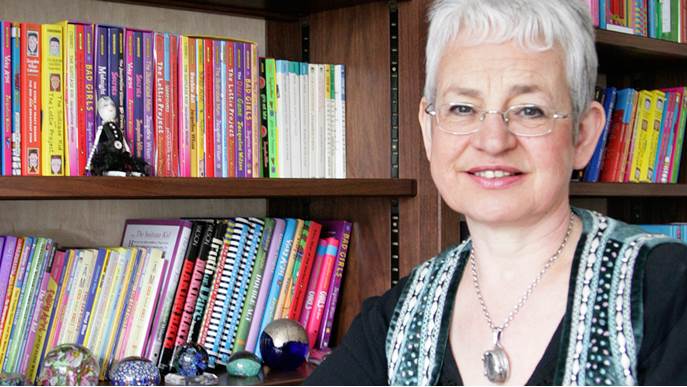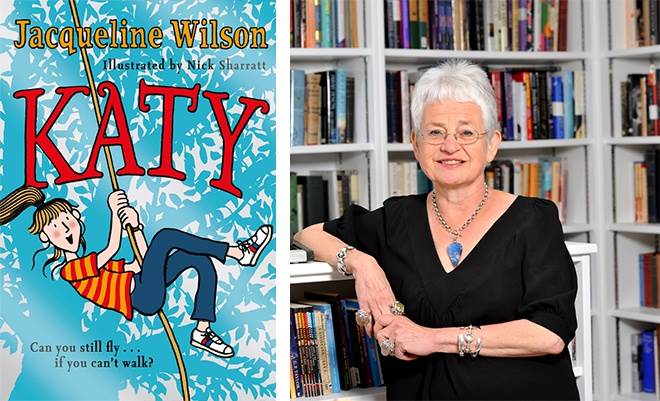Can you still fly... if you can't walk? Jacqueline Wilson on her new book, Katy
Published on: 5 Tachwedd 2015 Author: Alex Strick
BookTrust disability consultant Alex Strick talks to Jacqueline Wilson about the portrayal of disability in books and Katy, her recent reimagining of the children's classic.

I understand that you loved What Katy Did when you were a girl, only for it to be rather 'tainted' in adulthood when you became aware of its less than positive messages about disability. Was it a gradual realisation?
I read What Katy Did many times as a child - it was one of my favourite books. I was always irritated by saintly Cousin Helen and felt it unfair that Katy had to endure the consequences of her terrible accident and learn to be good and patient and the little Angel of the House. I read What Katy Did to my daughter when she was seven or eight and she loved the story too - and actually liked the Cousin Helen part most of all - but by then I felt that times had changed and that maybe it wasn't a good idea to suggest that if disabled children were only religious and obedient enough they might actually recover.
Was it difficult to realise that the book you had loved for so long was in some ways flawed?
I don't think you can blame a book for reflecting the attitude of its time. There are quite a few Victorian children's books where disabled children learn to walk again - Colin in The Secret Garden, Clara in Heidi, etc. They're very stirring books but we generally don't nowadays believe that faith or fresh air can work miracles.

Not a question - but a comment. Thank you for enabling some of us fall back in love with the story of Katy, with its new characters and rather more authentic picture of spinal injury! You've always included a diverse range of characters in your books, including disabled characters. Is this something that is close to your heart?
I find I generally write about children who are 'different' in some way - they might be in care, they might be living in unhappy homes, they might have problems, they might be bullied, they might be ill or disabled. I find these children interesting and feel fiercely protective towards them.
Did you have any concerns about experimenting with a well-loved classic and have you met with any resistance to the idea?
I do worry about reworking a well-loved classic. It seems a very impertinent thing to do. However, in this case, I truly think there's a good reason. I want to show my readers what it's really like to be disabled, and that it's still possible to lead a fulfilling and dynamic life even if you can't ever walk again.
The result is a triumph- especially where the depiction of disability is concerned. Did you consult any disabled children / young people in the process and how valuable was this?
Over the years I've met many young people who use wheelchairs. Some have been in mainstream schools, others in special schools for children with disabilities. I've also become friends with Nicola Miles-Wildin, an actress with rheumatoid arthritis who uses a wheelchair. She was the dramatic star of the opening ceremony of the Paralympics.
We love the way you re-imagined the character of Helen - can you tell us more about how you created (or recreated) her?
I wanted Helen to be a positive role model for Katy, a highly successful and independent career woman. I decided she should be an admired academic - and I gave her some of Nicola's energy and determination.
What feedback have you had from readers young and old?
I've had wonderful feedback, with many people saying it's their favourite out of all my books. I've also been asked to be a Patron of Treloars school for disabled young people, and Stoke Mandeville hospital has been in touch with me to come and visit.
Have you heard of anyone being inspired by reading Katy to give the original book a go too?
I hope lots of children read the original book by Susan Coolidge. She has a delightful direct and lively writing style and invented utterly believable children.
Are there any other classics you'd be secretly tempted to revisit in this way? Would you ever do it again?
I did 'borrow' the psammead sand fairy from E. Nesbit's Five Children and It and have four modern children dig him up and persuade him to grant their wishes!






Add a comment